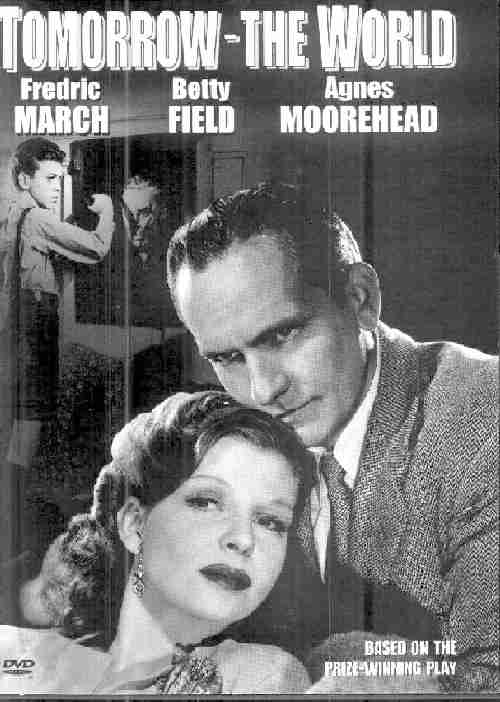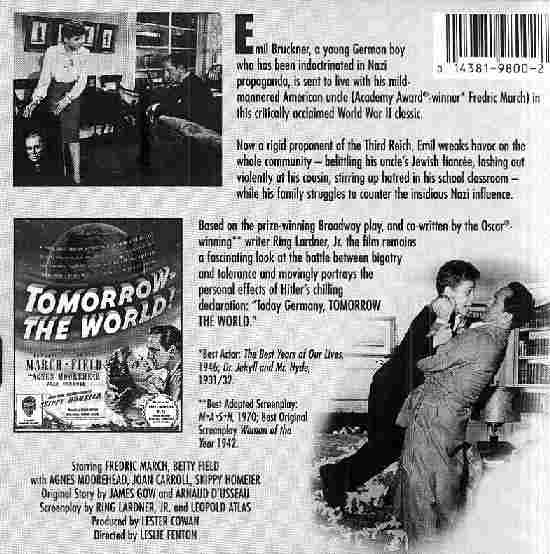
Movies Productions: Tommorow, The World! (United States, 1944)

Figure 1.--This film had a rather illustrious cast. The cover for the DVD is presumably a contemprary movie poster showing the adult stars. Notice Emil in the back ground wearing his Hitler Youth uniform slashing his father's portarit--perhaps the strongest image from the film.
|
An orphaned Hitler Youth comes to America to live with his mother's brother. The arrogance and contempt inculcated in him by the NAZIs strains his relationship with his new family and schoolmates. The family warmly tries to include the boy in their lives. They face, however, years of NAZI indoctrination by the Hitler Youth. Their efforts at rehabilitation are futile until an act un vilonce by the boy causes a belated change of heart. This World War II drama dealt with Hitler's seduction of German Youth. Few who saw it realized that it only scratched the suface of the Third Reich and how terribly successful the NAZIs were in deluding an entire generation of young people. It was Skippy Homeier's film debut. He had performed this role in live theater the year before. The film and play deal with a Hitler Youth boy who can not accept his father's oppostion to his beloved Führer and the NAZIs. He has one scene in both play and film in an Hitler Youth uniform.
Tommorrow the World! was a sucessful Broadway play in the Spring of 1943 during the height of World War II. Skippy Homeier was cast as the Hitler Youth boy Emil Bruckner. Ralph Bellamy played his uncle and Shirley Booth played his uncle's fianceé.
Film
Broadwayhas always been an important source of ideas for Hollywood, but rarely the reverse. The successful Broadway play was made into a film in 1944. Skippy was again past as Emil. Frederic March played the uncle and Betty Field played the fianceé. Agnes Morehead had a small part beautifully played. Joan Carroll plays the part of Pat Frame the daughter of widowed uncle. Three other boys are played by Rudy Wissler (Stan), Boots Brown (Ray), and Marvin Davis (Dennis). Ring Lardner Jr. co-wrote the script. Hollywood wanted a film that would match the popularity of the Broadway film. The film was directed by Leslie Fenton.
The Hitler Youth boy Emil in both the play and film was Skippy Homeier. We know very little about him, both his life and film career. Skippy was born on October 5, 1930 in Chicago. This is virtually all we know about him. As far as we kno, Tommorrow the World, was Skippy's only major role. As an adult, he tried to make a career out of acting. He had many bit parts on television, but we do not know of any major roles. Thyere was not much difference as to when the Broadway play was produved and when the film came out. Skippy would have ben 11-12, perhaps 13 yeras old.
The description of the plot here comes from the play. We belive the film plot is very similar. Emil Bruckner, a 13-year old ardent Hitler Youth boy, loses both his parents. They were both political disidents and pacifists and after being arrested by the Gestapo die in concentration camps. Emil comes to live with his colest relative--his father. Her lives in a typical, small American town. The tension in the production is that the innosence of small-town America comes face to face with a NAZI indicrinated boy. There are some differences between the play and film, although many of the same scenes occur. We have reproduced the play plot here as it is a fuller account than what we have for the film.
Emil wears a variety of clothes. Most notable is his Hitler Youth uniform, but with black kneesocks.. He also wears a black knicker suit, white shirt, and tie with black stockings and rather high buttoning shoes. The Hitler Youth uniform in the play seems basically authentic. It includes a brown shirt, black short pants, and black shoes with a Hitler Youth belt buckle. As in the play he werars a necktie rather than kercvhief. [HBC has noted HJ boys wearing neckties in the early years, but the kerchief was much more common.] His HJ arm band was the red band and black swasastika in a white type as worn by the SA and SS. It is not the Hitler Youth arm band with the square swasastika and white stripe. In the movie Emil wesrs a kneckerchief. At school, the boys where typical 1940s American boys clothes, long sleeved sports shirts, and long trousers. Emil after the early scene in knickers wears thesame long pants outfits. The boys also appear in rather full cut suits or sports jackets with long trousers. None of the boys wear shorts. One Scout wears the knickers uniform, which the Bouy Scout Association by 1944 had phased out. Some Scouts presumably still wore the old knickers uniform.

Figure 2.--While the play and film painted some of the evil of NAZI Germany, in many ways it is a rather naive depiction of the true evil of NAZI Germany. It is a good example of how the American film industry was mobilized as part of the War effort.
|
Assessment
Both the play and the film were sucessful. American audiences were horrified at the depiction of NAZI indoctrination of the young. Of course we now know that these productions only cratched the surface of the horrors prepetrated by the Third Reich. Hitler did not at first appreciate the importance of the Hitler Youth, but they came to play an impofrtant role in his rise to power. Hitler soon grasped the potential. He said that if he had a chance to influence a child until he was six, he would have him forever...hence the NAZI slogan, "Today Germany, Tomorrow the World". It is from this slogan, of course that the title of the film was derived.
I'm not sure just what year the film was set. Before the war, getting a boy out of German would have been difficult. After the War began it would have been virtually impossible. The ulta pastrotic presumaby would have not like the ideaa of sending a German boy to Anerica.
Another problen with the film is Emil's sudden conversion at the end of the film. Emil's conversion from dedicated Hitler Youth to compliant family member is rather conmtrived and far to sudden. Not very believable.
Still the film is entertaing to watch and generally well acted. Hitler himself had said that he wanted a new generation that was "a hard as Krup steel" with the "preadatoy instincts of the beast". With these children would rule "Germany" today and tomorrow the world. would
Children and the NAZIs
HBC thinks that the play and movie did not fully appreciate the evil of NAZI Germany. We are not at all certain that even family members would have been allowed to have taken a boy out of Germany. We are also not certain how the children of discedents were dealt--especially if they had no family in Germany. Also I wonder how this woukd have affected the boy's standing in the Hitler Touth. I have read accounts as to how children were taken away from oarents in some of the Comminist countries after the WAr. I have not read of similar accounts in Germany. Presumably they would have gone to an orphange. The chance of anti-NAZI Americans getting them out of such institutions is questionable. One reviwer, for example, writes, "This movie was about a young cousin from Germany being sent to America to Live with relatives as Germany became war torn." HBC is not sure who in Germany would have sent a boy to America. If he had realtives they would have cared for him. Certainly NAZI authorities would not have sent a German boy to America.
A HBC reader comments, "On an historical note, there were programs in place allowing children to leave the country. The protagonist of Reunion is also shipped off to America
at the end. In most cases, the children were Jewish or foreigners, and not HJ or Jungvolk members. Since Emil is an orphan, he would have been placed in an orphanage, and not allowed to expatriate for the Youth were too valuable to loose, even if their father was a traitor to the Reich. Emil's father and Uncle Mike do not seem to be blood-relations in the film, just old friends. Also, an interesting side note is that Mike allows his daughter
Patricia to call him by his first name and not `father'. [This reminds HBC of Aticus in To Kill a Mockingbird.] I found this strange, even though it was used to show the `corruption' of American liberalism" from Emil's point of view."
HBC would disagree slightly with the above comment. HBC knows of no program allowing children to leave Germany. We do know that many Jewish families acted on their own to get children out. The NAZIs in the early years allowed Jews to leave Germany, although they could not take their property except for a few personal possessions. The policies were at first to encourage Jews to leave not to kill them. Many Jewish families with money or with overseas families did send their children. especially the boys, abroad. The problem was not with the NAZIs, it was in getting visas from countries to accept them. America had very restrictive emigration comtrols and there wasa string anti-semetic element in the State Department. A the HBC reader mentions, getting Aryan children out of Germany was a different matter. We believe that in the case of a child whose parents had been arrested, it would have been very difficult. This would have presumably been especially true of a boy Emil's age who was an active HJ boy and presumably would have had no desore to leave Germany. The play and film is based in a rather American presmise that the family should decide. We suspect in NAZI Germany, the desire of the family, especially overseas realtives, would have had no impact.
The subject of NAZI Germany's Hitler Youth has fascinated fim makers since the very first years of the Third Reich. Several films have been made specifically on the Hitler Youth, but it is a rare film about NAZI Germany that does not include a required scene with Hitler Youth boys. The most notable such scene is from the Broadway musical Cabaret. Information on several other Hitler Youth films, several made in Germany, are avialable on HBC. The first such film was made in Germany, Hitler Jugend Quex. While it looks rather hokey to us today, it had a powerful impact in mid-190s Germany. The prevelence of the Hitler Youth in movies is extrodinary. The much larger Boy Scout movement is rarely depicted in films. The Hitler Youth, however, is rarely left out in a film with a German setting from the late 1920s to 1945.
HBC

Navigate the Boys' Historical Clothing Web Site:
[Return to the Main movie Tm-Tz alphabetical page]
[Return to the Main Hitler Youth films page]
[Return to the Main Hollywood World War II page]
[Introduction]
[Activities]
[Biographies]
[Chronology]
[Cloth and textiles]
[Clothing styles]
[Countries]
[Topics]
[Bibliographies]
[Contributions]
[FAQs]
[Glossaries]
Images
[Satellite sites]
[Tools]
[Boys' Clothing Home]
Created: August 27, 2001
Last updated: 9:02 PM 9/19/2006




